In this article we look at music intervals and ear training. We show you what musical intervals are and how to hear and play them on the guitar.
At the end of the article we provide several practical ear training exercises. If you make them part of your practice routine then your improvisation ability and all-round musicianship will quickly improve...
Music Intervals And Ear Training
We are going to identify several basic music intervals and show you how to hear them and play them.
We're not going to go into too much music theory; this lesson is all about providing you with the tools you need to identify and play common intervals.
What Are Musical Intervals?
In music, an interval is the space between any two notes. It can either be between consecutive notes (a melodic interval), or between notes played at the same time (a harmonic interval).
We'll be looking at melodic intervals in this lesson.
Intervals In Popular Tunes
The best way to learn how to identify intervals is to relate them to music you already know. Popular melodies, nursery rhymes, hymns and Christmas carols are ideal for this purpose.
For example, if you want to know what a perfect 5th sounds like, just imagine the first line of 'Twinkle, Twinkle Little Star'. The interval between the second and third notes is a perfect fifth. The interval between the first two notes of John William's theme E.T. theme is also a perfect 5th
The interval between the first two notes of both 'O Little Town Of Bethlehem' and those of 'Auld Lang Syne' are both perfect fourths.
Want to know what a minor second sounds like? Think Jaws (or John Williams' theme to be more precise!)
An octave? Somewhere Over The Rainbow!
[ad name="Google Adsense Lge Rec"]
Minor & Major Thirds
If you sing a major or minor arpeggio up from the root note then the interval between the first and second notes will be a third.
If you sing a major arpeggio, the interval will be a major third.
If you sing a minor arpeggio, the interval will be a minor third.
The diagrams below show intervals between notes in major and minor arpeggios.
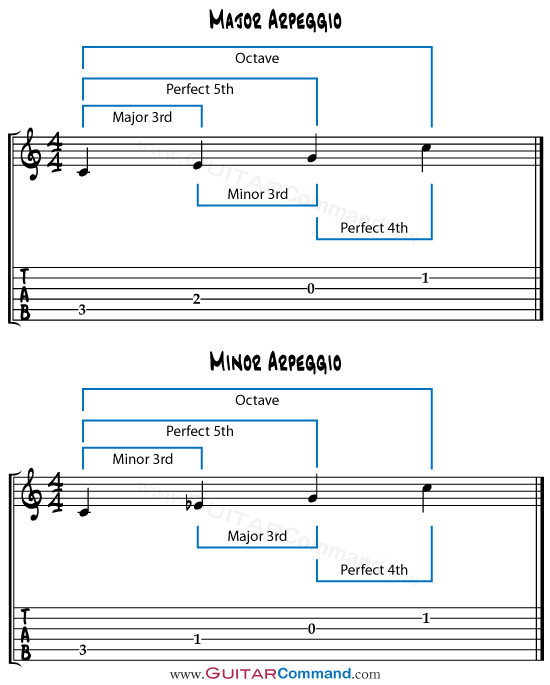
In this article, we are going to relate the intervals to the guitar neck.
Each interval will be shown in notation and tab, then as fretboard diagrams. The fretboard diagrams can be used anywhere on the guitar neck: the intervals between the notes will always be the same.
Note how each interval is played differently when spread across the 2nd (B) and 3rd (G) strings than when spread across any other adjacent strings. See the section on perfect fourths, below, for an explanation.
The following illustrations show how to play major and minor third intervals on the guitar.
Note that the fretboard diagrams below the tab do not show specific notes - they can be played anywhere on the guitar neck: the interval will remain the same.
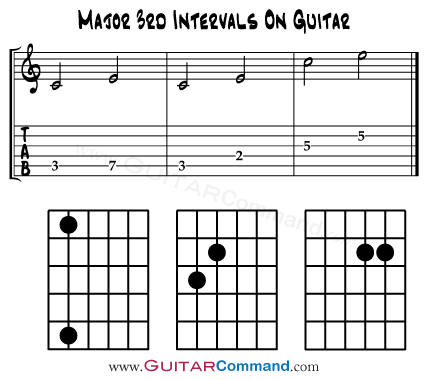
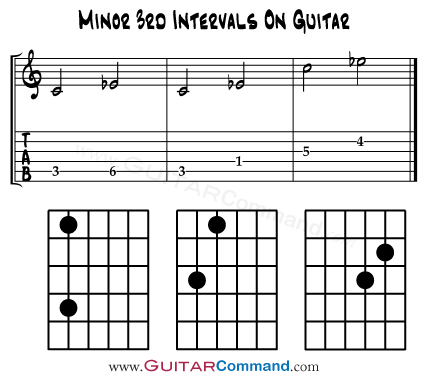
[ad name="Google Adsense Lge Rec"]
Perfect Fifths
When you sing either a major or a minor arpeggio, the third note is a perfect fifth from the root note. (See the major and minor arpeggio illustrations above.)
On a guitar, perfect 5ths can be played like this:
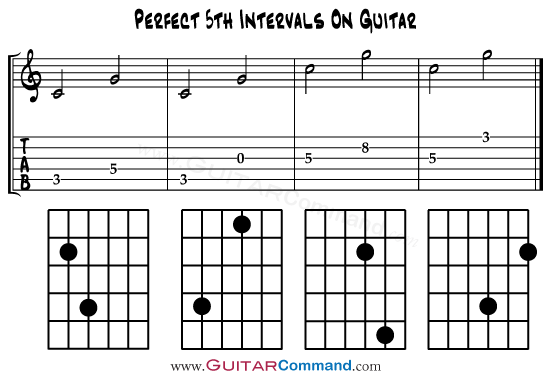
Perfect Fourths
As guitarists, we hear perfect fourths more than most! When a guitar is tuned, the interval between every neighboring string - apart from that between the 3rd and 2nd strings - is a perfect fourth.
The interval between the 3rd (G) and 2nd (B) strings is a major third. This is why adjacent string intervals are played differently between these strings.
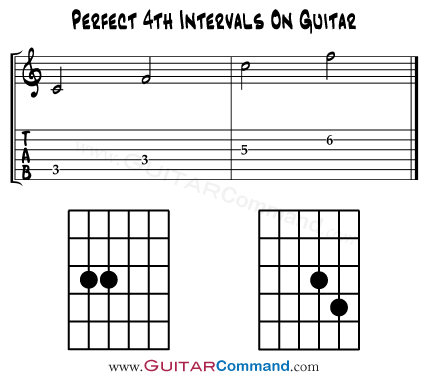
Seconds (maj & Min)
Seconds can either be major or minor. Confusingly, the interval between the first two notes of both a major and a minor scale is a major second.
Major seconds are also called 'whole steps', or 'tones'. The illustration below shows them on the guitar:

Minor seconds are also called 'half steps', or 'semitones'. The illustration below shows them on the guitar:
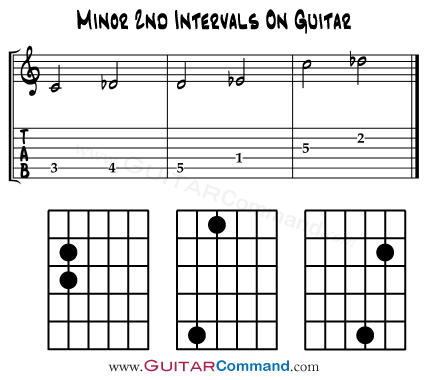
Other Intervals
There are several other intervals, but if you learn those listed above, and can hear, identify them and play them on the guitar, then you will have given yourself an excellent start.
Below are several exercises that you can use to further train your ear and master intervals.
Ear Training Exercises
Music Interval Training Exercise 1
Play any note on the fretboard, then randomly choose one of the intervals listed above. Sing, or imagine in your inner ear, this interval.
Now see if you heard the right note by playing the interval using the relevant diagram.
Music Interval Training Exercise 2
Play any note on the guitar fretboard. Then choose a random fret within an octave up or down from this note. Sing aloud, or imagine in your head, the note you expect to hear when the new note is played. Then play the note to see if you were right. You may choose intervals that are not covered above: this is fine. In time you should train your ear to recognise all of the intervals.
Additional Ear Training
1. Listen out for intervals in every piece of music you hear or play. See if you can identify them.
2. When you are improvising, start to notice the intervals between each note. Try to 'hear' the notes before you play them.
We have tried to keep things simple in this lesson. If you do have any questions, please feel free to ask them in the comments below.
Read These Articles Next



This is an important lesson for all improvising guitarists. I will refer students to this page.
Per